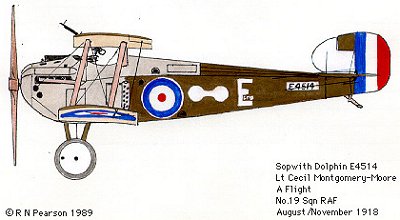The Sopwith Dolphin 5F.1:
Historical Notes:
The Dolphin was test flown during June of 1917, and was in France by mid month for operational trials. It's construction was essentially no different than other Sopwith machines, with a spruce framed fuselage which was wire braced and covered with fabric. The wings were also framed in spruce, and both landing and lift bracing wires were fitted. Both upper and lower wings were fitted with ailerons, which helped to account for the Dolphin's surprising maneuverability. The design was altered several times, most notably with the replacement of the automobile style radiator (like the Se-5a) with radiators positioned on either side of the front fuselage to keep the 200hp Hispano-Suiza engine cool. First deliveries of the Dolphin were made by the end of 1917, and began to make their first real impact in combat with the beginning of the German offensive of March of 1918.
What made the Dolphin truly unique was its armament arrangement. Mounted in the cowling were two Vickers .303 machine guns, while mounted on the center section of the top wing were two Lewis guns. The Lewis guns presented a unique problem. They were meant to fire up at a 45 degree angle (for attacks from below), but these caused problems for the pilot, among them being the nasty habit of knocking him in the head while maneuvering. Therefore, many pilots removed one or both Lewis guns, and if one was retained, it was shifted more to one side. One squadron, No. 87, decided to mount both Lewis guns on either wing. Only one drum (97 rounds) was attached, and once empty could not be reloaded. But this configuration gave the Dolphin a four-gun punch at the crucial moment, which could be simply devastating in aerial combat or ground attack. In this manner, it became the first truly multigunned fighter in history (a few other planes received armament comparable, but not on a production basis). Dolphins were often used for ground attack purposes because of this heavy armament. A total of 1,532 Dolphins were built. The United States purchased five Dolphins for study, but the end of the war brought any production plans to a halt.
The Dolphin was not an outstandingly maneuverable fighter, but it got the job done and when used properly, was a dangerous opponent.
Basic performance statistics: Dolphin 5F.1 (trial report M.172A)
Engine: Hispano-Suiza 200 hp
Weight: empty 1,406
Maximum speed: 111.5 mph at 10,000 feet
Climb rate: to 10,000 feet.... 11 min, 40 sec.
Service ceiling: 18,500 feet
Flight endurance: 1.75 hours
Basic Specifications (vary from model to model):
Manufacturer: Sopwith Aviation Company, Ltd.
Dimensions: Span 32 ft, 6 in; Length 22 ft, 3 in; Height: 8ft, 6 in; Stagger: -12 in; Dihedral: 2.5 deg.; Incidence: 2 deg.
Areas: Wings 263.25 sq ft; Rudder 8 sq ft
Fuel: Main tank 27 gallons; oil 4 gallons; water: 7.5 gallons
Armament: twin Vickers machineguns synchronized to fire through the airscrew; one or two Lewis guns mounted on the forward spar of center section; four 25lb bombs
Typical ammo load: 400 rounds per gun
Primary sources: "Jane's Fighting Aircraft of World War I, 1919 (1990 reprint); "British Aeroplanes, 1914-1918," J.M. Bruce; "German Aircraft of the First World War," Gray and Thetford; "German Air Power in World War I," Morrow; "Aircraft Camouflage and Markings 1907-1954," Robertson et al; "Military Small Arms of the 20th Century," Hogg and Weeks.
Fighting and winning in the Dolphin 5F.1:
The primary asset of the Dolphin is its armament. It was difficult to develop and simulate the Dolphin's unique machine gun array, so a compromise was struck. Whereas the ability to shoot up at a 45 deg angle is of limited use in CFS, it was decided to drop one Lewis gun, and have the other positioned on top of the wing to fire forward. This gives the Dolphin pilot a 3 gun array in combat. Care must be taken, however, when engaging enemy planes, since convergence with 3 guns was difficult. Fly the plane against computer opponents and learn where the rounds fall. Once you know the plane's system, you can use it's multi-gun layout to deadly effect. The Dolphin is most effective in team games, when it has a more nimble companion to provide some protection. The companion can set up an enemy aircraft, and the Dolphin can then attack it and unleash a hail of lead into the enemy machine. Several solid bursts can easily so cripple an enemy as to place him at your mercy.
If you fly it alone on the Zone, be careful to pick and choose your fights. Don't twist and turn with more nimble opponents. Pick an enemy plane who is distracted (going after somebody else) or appears damaged, and use the Dolphin's superior firepower to end their days on earth. The Dolphin can "dive and zoom," but does not have sufficient speed to make this too effective. Finally, players on the Zone may accuse you of cheating (the heavy armament). If so, patiently explain to them the gun arrangement on the Dolphin. If they don't believe you, refer them to our site.
